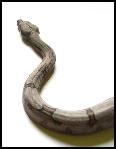» Site Navigation

0 members and 918 guests
No Members online
Most users ever online was 47,180, 07-16-2025 at 05:30 PM.
» Today's Birthdays

» Stats

Members: 75,937
Threads: 249,130
Posts: 2,572,295
Top Poster: JLC (31,651)
|
-
BPnet Veteran


Re: Red Tail Boa and IBD and transmission to BP's
 Originally Posted by Skiploder

As for 70% of boas carrying IBD - again no one knows the true rate of occurence. The testing is invasive and inaccurate and so few people actually pay for histopathology that the true rate of occurrence is unknown. However, per the Merck Veterinary manual, up to 50% of boas tested are carriers.
Per this link - up to 33% of necropsied boas were carriers:
https://netfiles.uiuc.edu/doortiz2/www/IBD.pdf
A large number of boas never see a vet in their lives, and most who do see one because something is wrong with them. Same with the necropys...a person is more likely to have one done if they don't know why their animal died. Therefore, the chance that boas examined by vets have IBD is greater than the population of boas as a whole.
-
The Following 3 Users Say Thank You to Aeries For This Useful Post:
Eventide (10-13-2009),JohnAvilla (10-13-2009),Wh00h0069 (10-13-2009)
-
Re: Red Tail Boa and IBD and transmission to BP's
 Originally Posted by Aeries

A large number of boas never see a vet in their lives, and most who do see one because something is wrong with them. Same with the necropys...a person is more likely to have one done if they don't know why their animal died. Therefore, the chance that boas examined by vets have IBD is greater than the population of boas as a whole.
Great point.
Eddie Strong, Jr. 
-
-
BPnet Veteran


Re: Red Tail Boa and IBD and transmission to BP's
The prevalence was especially high in Boa constrictor subspecies
(>33 per cent) and in the tree boa,Corallus annulatus (28 per
cent). The disease rarely or never occurred in ground boas
(Acrantophis species), rainbow boas (Epicrates species) and
anacondas (Eunectes species). The most remarkable result of
this survey was the absence of the disease among 301 pythons
examined postmortem.
seriously ppl atleast read the information posted.
-
The Following User Says Thank You to nixer For This Useful Post:
Jason Bowden (10-16-2009)
-
BPnet Veteran


Re: Red Tail Boa and IBD and transmission to BP's
 Originally Posted by Aeries

A large number of boas never see a vet in their lives, and most who do see one because something is wrong with them. Same with the necropys...a person is more likely to have one done if they don't know why their animal died. Therefore, the chance that boas examined by vets have IBD is greater than the population of boas as a whole.
just boas? im sure many many reptiles period have never been to a vet.
out of those im sure most wouldnt pay for the tests unless they had a big collection, breeders, zoos.
unfortunately there is way too many ppl that dont care enough to treat an animal whose price was not much more than just the standard vet visit and how many died and ppl just tossed them in the trash
-
-
BPnet Veteran


Re: Red Tail Boa and IBD and transmission to BP's
From the same paper linked (re: liver biopsies):
"The disease affects all organ systems and the inclusions
can be found in virtually all cell types. The epithelia of
the liver, pancreatic gland, kidneys and gastric mucosa contain
the highest density of affected cells (Garner and
Raymond 2004).
"The best way to achieve diagnosis in a living snake is to
perform a wedge biopsy of the liver through a flank incision.
A biopsy of the tonsils on the surface of the oesophagus or
a biopsy of the gastric mucosa is also an option, but requires
an endoscope suitable for the size of the snake (Garner and
Raymond 2004; E. R. Jacobson, personal communication).
Skin biopsies are another possibility, but are not as sensitive
as a liver biopsy. However, the sensitivity can be
improved by taking several skin biopsies (Garner and
Raymond 2004)."
Granted, this doesn't say at what stage of the illness it affects nearly all cell types; however, it does seem, from the reading, that it doesn't take long.
About the statistics on how many boas have the disease: Given what others mentioned about the frequency of affected snakes given biopsies (even less common than those that get taken to the vet), 33% is going to be an upper limit, at best.
EDIT: Please note I'm not saying liver biopsies are 100% accurate all the time.
Last edited by Eventide; 10-13-2009 at 02:53 PM.
Periodic Table Pythons - Quality, captive-bred pythons? It's elementary!
1.0 VPI Axanthic, 1.0 Genetic Stripe, 1.0 Red Axanthic, 1.0 Lesser Platinum, 1.0 50% Het Albino, 0.1 Albino, 0.1 Het VPI Axanthic, 0.1 Het Red Axanthic, 0.1 Het G-Stripe, 0.1 Woma, 0.1 Mojave, 0.1 Normal.
-
-
Re: Red Tail Boa and IBD and transmission to BP's
This is very interesting... I was just offered a hypo BCI in a trade (for electronic equipment), and now I'm worried about accepting. I was thinking of taking the snake, but will it be a constant risk with my BP collection? And are BCIs and red-tails the same thing? Sorry, I know nothing about boas yet! 
We do have a good herp vet around here, so maybe I could take him straight to the vet - followed by a good long quarantine. Hmmmmmm. 
Last edited by Lolo76; 10-13-2009 at 03:15 PM.
Lolo's Collection...  Ball Pythons: 0.4 Normals, 1.0 Pastel, 1.1 Mojaves, 1.0 Black Pastel, 2.0 Spiders, 0.1 Lesser, 1.0 Orange Ghost, 0.1 Honeybee
Ball Pythons: 0.4 Normals, 1.0 Pastel, 1.1 Mojaves, 1.0 Black Pastel, 2.0 Spiders, 0.1 Lesser, 1.0 Orange Ghost, 0.1 Honeybee
0.1 Spotted Python, 1.1 Stimson's Pythons, 1.0 Jungle Carpet Python
3.4 Corn Snakes, 1.1 Western Hognose Snakes, 1.2 cats, and 1.0 dog (47lb mutt)
-
-
Re: Red Tail Boa and IBD and transmission to BP's
 Originally Posted by Aeries

A large number of boas never see a vet in their lives, and most who do see one because something is wrong with them. Same with the necropys...a person is more likely to have one done if they don't know why their animal died. Therefore, the chance that boas examined by vets have IBD is greater than the population of boas as a whole.
Read the enitre article. If that's the case, why was the disease absent (in the same study) in over 300 pythons?
Better yet, e-mail Dr. Jacobson and ask him two questions:
(1) How prevalent does he think the disease is in boa constrictors?
(2) What does he think of the level of interest/concern from the reptile community?
-
-
Re: Red Tail Boa and IBD and transmission to BP's
 Originally Posted by Lolo76

This is very interesting... I was just offered a hypo BCI in a trade (for electronic equipment), and now I'm worried about accepting. I was thinking of taking the snake, but will it be a constant risk with my BP collection? And are BCIs and red-tails the same thing? Sorry, I know nothing about boas yet! 
We do have a good herp vet around here, so maybe I could take him straight to the vet - followed by a good long quarantine. Hmmmmmm. 
A vet will do you no good in diagnosing IBD unless you want to spend a lot of money on a test that may tell you nothing.
As for QT - some boas can be asymptomatic for years..........how long were you planning on keeping the animal in QT?
-
The Following User Says Thank You to Skiploder For This Useful Post:
Jason Bowden (10-16-2009)
-
Re: Red Tail Boa and IBD and transmission to BP's
 Originally Posted by Eventide

From the same paper linked (re: liver biopsies):
"The disease affects all organ systems and the inclusions
can be found in virtually all cell types. The epithelia of
the liver, pancreatic gland, kidneys and gastric mucosa contain
the highest density of affected cells (Garner and
Raymond 2004).
"The best way to achieve diagnosis in a living snake is to
perform a wedge biopsy of the liver through a flank incision.
A biopsy of the tonsils on the surface of the oesophagus or
a biopsy of the gastric mucosa is also an option, but requires
an endoscope suitable for the size of the snake (Garner and
Raymond 2004; E. R. Jacobson, personal communication).
Skin biopsies are another possibility, but are not as sensitive
as a liver biopsy. However, the sensitivity can be
improved by taking several skin biopsies (Garner and
Raymond 2004)."
Granted, this doesn't say at what stage of the illness it affects nearly all cell types; however, it does seem, from the reading, that it doesn't take long.
About the statistics on how many boas have the disease: Given what others mentioned about the frequency of affected snakes given biopsies (even less common than those that get taken to the vet), 33% is going to be an upper limit, at best.
EDIT: Please note I'm not saying liver biopsies are 100% accurate all the time.
Read Jacobson's papers on IBD. He actually wrote two excellent articles in Reptiles Magazine.
After you look those up you will learn:
A liver biopsy can only detect IBD if there are actual inclusion bodies present in the liver.
While the presence of inclusions is a diagnostic for the disease, the absence of these inclusion bodies does not necessarily indicate that the snake is not diseased or is free from IBD.
In other words - a negative biopsy may mean nothing.
Last edited by Skiploder; 10-13-2009 at 04:03 PM.
-
-
Registered User


Re: Red Tail Boa and IBD and transmission to BP's
 Originally Posted by Lolo76

This is very interesting... I was just offered a hypo BCI in a trade (for electronic equipment), and now I'm worried about accepting. I was thinking of taking the snake, but will it be a constant risk with my BP collection? And are BCIs and red-tails the same thing? Sorry, I know nothing about boas yet! 
We do have a good herp vet around here, so maybe I could take him straight to the vet - followed by a good long quarantine. Hmmmmmm. 
I keep my red tail right next to my ball and havent any problems also hypos are a colombian BCI morph I say go for it red tail boas are full of personality and adorable!
0.1 Delilah - Ball Python
1.0 Silas - Colombian Red Tail Boa
1.0 Drew - Ball Python
0.1 Benny - Colombian Red Tail Boa
0.1 Zooey RIP - Ball Python
-
The Following User Says Thank You to DarkComeSoon For This Useful Post:
 Posting Permissions
Posting Permissions
- You may not post new threads
- You may not post replies
- You may not post attachments
- You may not edit your posts
-
Forum Rules
|









 Reply With Quote
Reply With Quote


